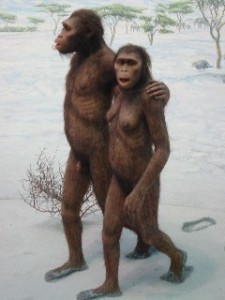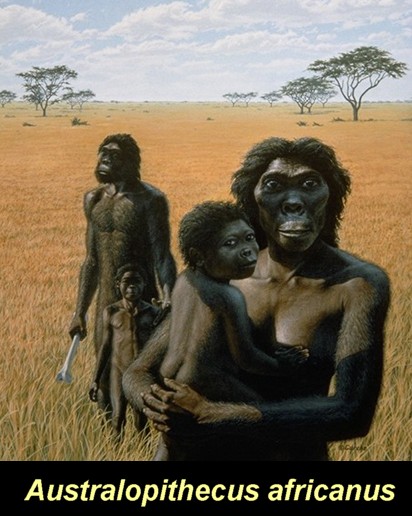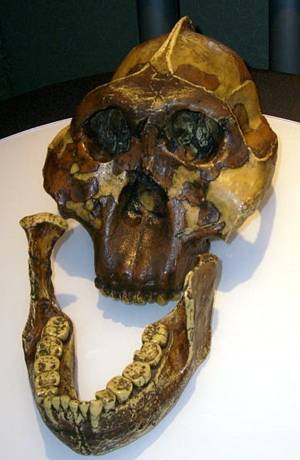Hi mods and fellow istoryans,
I just wanna make a thread for all related topics, videos, images that serve as evidence for Evolution. It would be nice if you guys could also share your materials.
So for now, here's mine, and there's more to come.
Understanding Genetics: Human Health and the Genome
Scientists Use DNA to Find Our Newest Relatives, the Denisovans
Gone but not Forgotten, Their DNA Lives on in Melanesians
portrait_barry.jpg
by Dr. Barry Starr, Stanford University
January 6, 2011
Scientists found humankind's newest relative, the Denisovan, by looking at the DNA of a thirty thousand year old fossilized finger from the Denisova Cave in Siberia. This is the first time DNA has been used to discover a new hominid. As scientists get better and better at looking at ancient DNA, they may find additional relatives this way too.
Our newest relative was
identified from the DNA of
a fossilized pinky found
in this cave.
Finding new hominids by looking at DNA has another advantage--scientists can learn whether any of that DNA lives on in modern humans. Scientists had already shown that 1-2% of non-African DNA might have come from Neanderthals. Now it looks like 4-5% of Melanesian DNA may have come from Denisovans.
Apparently before humans wiped out all of their competition, they had children with some of them first. This legacy lives on in modern human DNA.
Looking at the DNA of related hominids is also changing how scientists look at and think about human prehistory. Before scientists could sequence DNA, there were two main theories to explain the fossil evidence.
The Out of Africa theory held that all humans evolved in Africa and then spread out and destroyed any hominid species they found. The multiregional hypothesis proposed that each ethnic group of humans evolved separately.
Looking at the DNA of modern humans pretty much eliminated the multiregional hypothesis. Everyone's DNA is way too similar to have evolved separately.
But it does look like the hominids from different regions of the world may have contributed their DNA to specific human groups. This isn't quite multiregional hypothesis but it does have some of the same consequences. Different groups of humans have small amounts of DNA that evolved in a completely different context.
It will be interesting to see if this "other" DNA contributes to any special traits of certain populations. Or if they are really just markers from human's distant past that no longer do much of anything.
Being able to look at DNA promises to shake up this field like it has nearly every other field in biology. New results with human and, hopefully, hominid DNA are going to be coming in fast and furious as sequencing gets cheaper and cheaper. This won't only help everyone live longer and healthier lives, but it will also help scientists learn about humankind's past and how all humans are related in ways they never would have thought possible.
Results 1 to 10 of 54
-
08-02-2011, 02:32 AM #1
 A Repository of Useful Links/URLs Under the Subject of Evolution
A Repository of Useful Links/URLs Under the Subject of Evolution
-
08-02-2011, 02:39 AM #2
 Re: All About Evolution
Re: All About Evolution
also, check out this nice interactive documentary
Interactive Documentary | Becoming Human
thanks
-
08-02-2011, 03:13 AM #3
 Re: All About Evolution
Re: All About Evolution
Im always intrigue with our Primitive Ancestors, and Im always thrilled to share what I have researched. You may already know some topics, but it is always good to share info to the ones who wants to learn, and are new to evolution. So lets start 7 to 6 Million years ago.
The Human Lineage Through Time | Becoming Human
Sahelanthropus tchadensis essay | Becoming Human
Sahelanthropus tchadensis
Found: 2001
Where: Toros-Manalla site 266, Chad
Team leader(s): Michel Brunet, Alain Beayvilain
Temporal range: 7 to 6 million years ago


Last edited by orcgod; 08-02-2011 at 03:28 AM.
-
08-02-2011, 03:22 AM #4
 Re: All About Evolution
Re: All About Evolution
Orrorin tugenensis
Found: October 2000
Where: Tugen Hills, Kenya
Team leader(s): Martin Pickford, Brigitte Senut
Temporal range: 6.1 to 5.8 million years ago
Orrorin tugenensis essay | Becoming Human

Ardipithecus kadabba
Found: 1997
Where: Middle Awash, Ethiopia
Team leader(s): Tim White, Gen Suwa, Yohannes Haile Selassie
Temporal range: 5.7 to 5.2 million years ago
Ardipithecus kadaba Essay | Becoming Human


Last edited by orcgod; 08-02-2011 at 03:29 AM.
-
08-02-2011, 03:35 AM #5
 Re: All About Evolution
Re: All About Evolution
Ardipithecus ramidus
Found: December 1992
Where: Aramis, Ethiopia
Team leader(s): Tim White
Temporal range: 4.5 to 4.2 million years ago
Ardipithecus ramidus essay | Becoming Human


Australopithecus anamensis
Found: September 1994
Where: Kanapoi and Allia Bay, Kenya
Team leader(s): Meave Leakey, Alan Walker
Temporal range: 4.1 to 3.9 million years ago
http://www.becominghuman.org/node/au...namensis-essay


Last edited by orcgod; 08-02-2011 at 03:40 AM.
-
08-02-2011, 03:44 AM #6
 Re: All About Evolution
Re: All About Evolution
Kenyanthropus platyops
Found: August 1999
Where: Lomekwi and East Turkana, Kenya
Team leader(s): Meave Leakey
Temporal range: 3.5 to 3.2 million years ago
Kenyanthropis platyops essay | Becoming Human


Australopithecus afarensis
Found: November 1974
Where: Hadar, Ethiopia and other sites in Ethiopoia, Kenya, Tanzania
Team leader(s): Donald C . Johanson
Temporal range: 3.9 to 2.9 million years ago
Australopithecus afarensis essay | Becoming Human


Last edited by orcgod; 08-02-2011 at 03:49 AM.
-
08-02-2011, 03:57 AM #7
 Re: All About Evolution
Re: All About Evolution
Australopithecus africanus
Found: October 1924
Where: Taung also Sterkfontein and Makapansgat, South Africa
Found by: Raymond Dart
Temporal range: 3.0 to 2.0 million years ago
Australopithewcus africanus essay | Becoming Human


Australopithecus garhi
Found: November 1997
Where: Bouri, Ethiopia
Team leader(s): Berhane Asfaw , Tim White
Temporal range: 2.5 million years ago
Australopithecus garhi essay | Becoming Human




Paranthropus aethiopicus
Found: August 1985
Where: Lake Turkana, Kenya
Team leader(s): Alan Walker, Richard Leakey
Temporal range: 2.7 to 2.5 million years ago
Paranthropus aethiopicus essay | Becoming Human



Last edited by orcgod; 08-02-2011 at 04:03 AM.
-
08-02-2011, 04:08 AM #8
 Re: All About Evolution
Re: All About Evolution
Paranthropus robustus
Found: June 1938
Where: Swartkrans, Kromdraai and Drimolen, South Africa
Team leader(s): Robert Broom
Temporal range: 2.0 to 1.2 million years ago
Paranthropus robustus | Becoming Human



Paranthropus boisei
Found: July 1959
Where: Olduvai Gorge, Tanzania
Found by: Mary Leakey
Temporal range: 2.3 to 1.4 million years ago
Paranthropus boisei essay | Becoming Human




Australopithecus sediba
Found: 15 August 2008
Where: Malapa Cave, South Africa
Found by: Matthew Berger
Temporal range:1.95 to 1.75 million years ago
Australopithecus sediba Essay | Becoming Human



Homo habilis
Found: November 1964
Where: Olduvai Gorge, Tamzania; Koobi Foora, Kenya
Found by: Mary Leakey, Louis Leakey
Temporal range: 2.5 to 1.6 million years ago
Homo habilis essay | Becoming Human


Homo rudolfensis
Found: August 1972
Where: East Turkana, Kenya
Team leader(s): Richard Leakey, Meave Leakey
Temporal range: 2.5 to 1.8 million years ago
Homo rudolfensis essay | Becoming Human


Homo erectus
Found: October 1891
Where: Trinil, Indonesia also China, northern, eastern and southern Africa
Team leader(s): Eugene DuBois
Temporal range: 1.8 million to 50 thousand years ago
Homo erectus | Becoming Human



Last edited by orcgod; 08-02-2011 at 04:27 AM.
-
08-02-2011, 04:37 AM #9
 Re: All About Evolution
Re: All About Evolution
Homo heidelbergensis
Found: October 1907
Where: Mauer, Germany also Europe generally, Africa, Asia
Named by: Otto Schoetensack
Temporal range: 800 to 350 thousand years ago
Homo heidelbergensis essay | Becoming Human



Homo sapiens
Named by: Carl Linnaeus
Temporal range: 175,000 years ago to present
Homo sapiens | Becoming Human


Homo neanderthalensis
Found: August 1856
Where: Feldhofer, Neander Valley, Germany also Europe generally, Central Asia
Named by: William King
Temporal range: 200 to 28 thousand years ago
Homo neanderthalensis essay | Becoming Human

Homo floresiensis
Found: September 2003
Where: Liang Bua cave, Flores Island, Indonesia
Team leader(s): Peter Brown, Michael Morwood
Temporal range: 100,ooo to 12,000 years ago
http://www.becominghuman.org/node/ho...esiensis-essay
[IMG]http://4.bp.blogspot.com/_Hbo7Ung0Hbg/Swio2wtajCI/AAAAAAAABAs/PftzvBldx *******LB1+reconstructed.jpg[/IMG]
*******LB1+reconstructed.jpg[/IMG]
[IMG]http://4.bp.blogspot.com/_ifNvMe6zXXc/TS5jrKk7gjI/AAAAAAAABpQ/iGgfYV_LcC0*******H-floresiensis.jpeg[/IMG]
Last edited by orcgod; 08-02-2011 at 04:41 AM.
-
08-02-2011, 07:00 AM #10
Advertisement
Similar Threads |
|






 Reply With Quote
Reply With Quote


